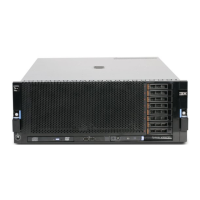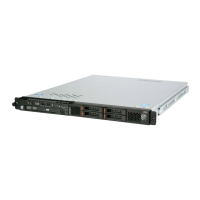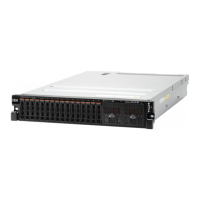Table 34. Light path diagnostics LEDs description (continued)
LED
Description
Power button/LED Press this button to turn the server on and off manually or to wake the
server from a reduced-power state. The states of the power-on LED
are as follows:
Off: Input power is not present, or the power supply or the LED
itself has failed.
Flashing rapidly (3 times per second): The server is turned off
and is not ready to be turned on. The power-on button is disabled.
This lasts approximately 10 seconds after input power has been
applied or restored.
Flashing slowly (once per second): The server is turned off and is
ready to be turned on. You can press the power-on button to turn
on the server.
Lit: The server is turned on.
Power supply error LED When this yellow LED is lit, it indicates that a power supply error has
occurred.
System error LED When this yellow LED is lit, it indicates that a system error has
occurred. A system-error LED is also on the rear of the server. This
LED is controlled by the IMM2. Additional information can also be
seen on the LCD display panel (see “LCD system information display
panel” on page 27 for more information).
Event logs
This topic provides an overview of the server generated event logs that contains the error codes and
messages to solve problems.
Error codes and messages are displayed in the following types of event logs:
• POST event log: This log contains the most recent error codes and messages that were generated during
POST. You can view the contents of the POST event log from the Setup utility (see “Starting the Setup
utility” on page 123). For more information about POST error codes, see Appendix D “UEFI/POST error
codes” on page 1925.
• System-event log: This log contains POST and system management interrupt (SMI) events and all events
that are generated by the baseboard management controller that is embedded in the integrated
management module (IMM). You can view the contents of the system-event log through the Setup utility
and through the Dynamic System Analysis (DSA) program (as IPMI event log).The system-event log is
limited in size. When it is full, new entries will not overwrite existing entries; therefore, you must
periodically clear the system-event log through the Setup utility. When you are troubleshooting an error,
you might have to save and then clear the system-event log to make the most recent events available for
analysis. For more information about the system-event log, see Appendix C “Integrated management
module II (IMM2) error messages” on page 475.
Messages are listed on the left side of the screen, and details about the selected message are displayed
on the right side of the screen. To move from one entry to the next, use the Up Arrow (↑) and Down Arrow
(↓) keys.
Some IMM sensors cause assertion events to be logged when their setpoints are reached. When a
setpoint condition no longer exists, a corresponding deassertion event is logged. However, not all events
are assertion-type events.
• Integrated management module (IMM2) event log: This log contains a filtered subset of all IMM, POST,
and system management interrupt (SMI) events. You can view the IMM event log through the IMM web
Chapter 4. Troubleshooting 161

